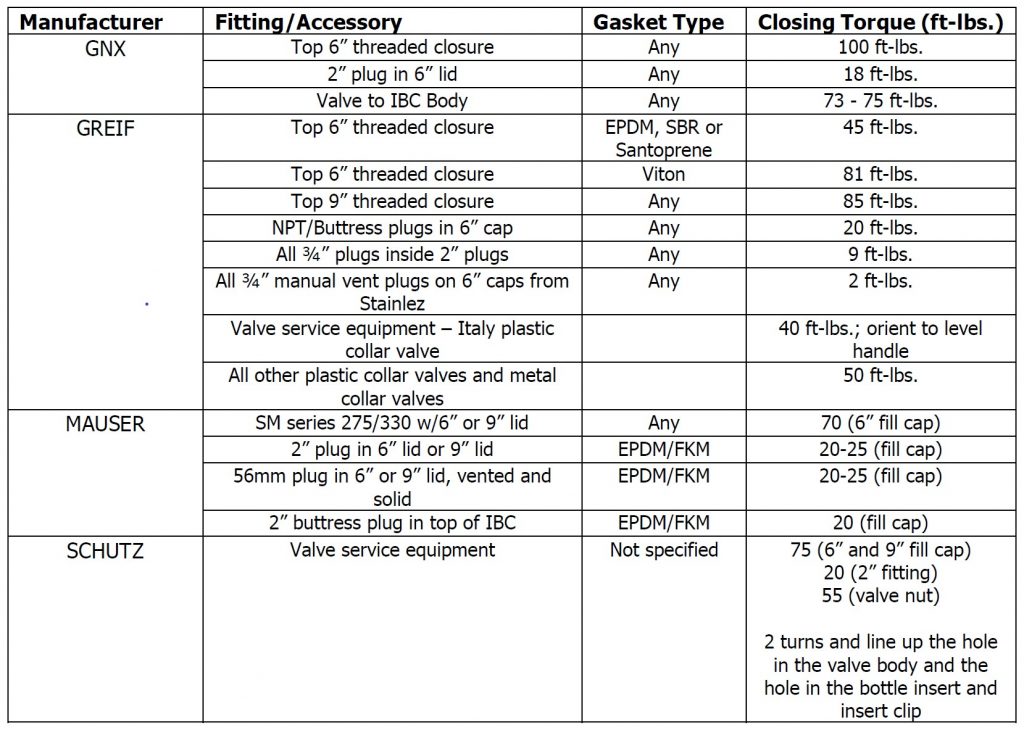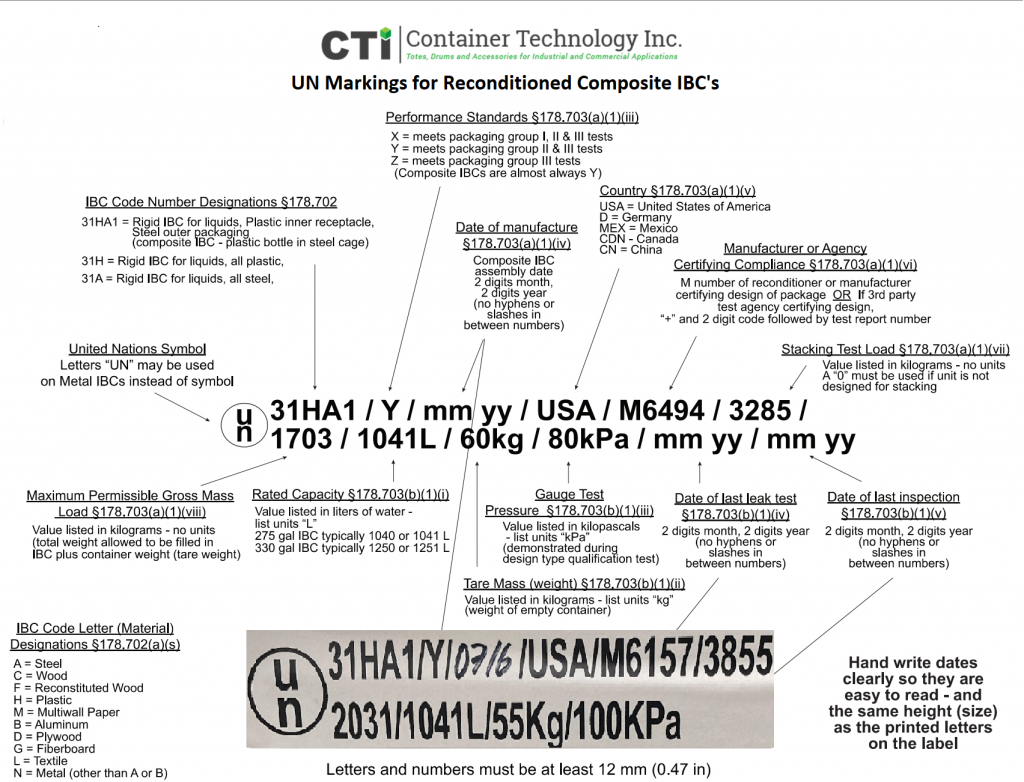Please see technical resources below:
- Empty Container Pick up & RCRA-Empty Container Standards
- Closure Instructions
- DOT Hazmat IBC Regulations
- IBC Label Guide
- Understanding IBC Stacking Limitations
- RIPA: Reusable Industrial Packaging Association
- Empty IBC’s: Keep Labels Intact
- Chemical Compatibility Chart
- Hazardous Materials Table
Empty Container Pick Up. What does “RCRA-Empty Container” mean? RCRA stands for “Resource Conservation and Recovery Act. Every container that previously contained an EPA regulated substance – – think hazardous materials plus – – must be RCRA-empty to be accepted for reconditioning. The regulation itself can be found here. –
ALL Containers: Must be shipped loose (not palletized) and stacked right-side-up with lids, rings and plugs securely fastened, Non-empty containers or containers not properly prepared for transportation may be refused and returned at the customer’s expense, For the protection of Container Technology Inc. and its customers, all wastes generated by the recycling and disposal process are handled by EPA compliant disposal facilities, This practice requires that all drums and IBC’s be completely empty, A container is “completely empty” when all free-flowing residues that cling to the interior surface of the container have been poured or scraped out, exposing 90% of the container’s original surface,
EPA’s 40 CFR 261-7 states that, with regards to most regulated residues, a container is empty if.
A. All wastes have been removed that can be removed using the practices commonly employed to remove materials from that type of container, e.g., pouring, pumping, or aspirating,
B. No more than 25 centimeters (one inch) of residue remains in the bottom of the container*,
C. No more than 0.3 percent by weight of the total capacity of the container remains in the container or inner liner if the container is greater than 110 gallons in size (IBC’s). Example for a 275-gallon IBC: 275 x 0.3% = .825 gallon
Note; DOT 49 CFR 173 says that all openings on the empty container must be closed and that all markings and labels must be in place as if the container were full of its original contents, DOT shipping papers are not required for transportation of drums bound for reconditioning via contract or private motor carrier, Common carriers may require DOT shipping papers and MSDS’s along with shipments, For residues of “P-List” products specifically listed by name in 40 CFR 261,33 (e), EPA says the container is empty only “if the container has been triple rinsed using a solvent capable of removing the product, or has been cleaned by another method shown to achieve equivalent removal,” EPA has explained this rule, saying that “one inch of waste material is an overriding constraint and may remain in an empty container only if it cannot be removed by normal means,”
Contact: Container Technology Inc. if you have questions about this certification.
Safety Data Sheets – are required and must be approved prior to shipping any new products to Intermediate Bulk Containers. Containers that do not meet the Empty Container Standard will be rejected upon arrival and returned at emptier expenses.
• Intermediate Bulk Containers does not accept title to any units that do not adhere to the empty container standard. The emptier is responsible for finding resolution for any non-compliant unit.
• Title to containers does not pass to Intermediate Bulk Containers until containers are unloaded and verified by Intermediate Bulk Containers personnel as empty.
Closure Instructions: This notification is provided as required in 49 CFR 178.2 ©. Instructions below describe procedures for closing packaging’s prior to shipment. All packaging supplied with lids, gaskets, clamp bands, locking rings, bolt rings, bungs, plugs, caps or other fittings must be closed for shipment using only the components supplied.
Prior to closing: 1. Inspect each closure to ensure: A) proper gasket is in place; B) threads and sealing surfaces are dry; c) both closure and gasket are in good condition. 2. Replace any defective gaskets, plugs or lids with new, defect free parts identical to the original packaging design.
Closing plug and cap fittings: 1. Insert the plug or cap into the appropriate opening and screw down ‘hand tight” until the gasket is in contact with the sealing surface. 2. Using a torque wrench capable of applying the proper torque as specified below, tighten the plug or cap until it reaches the pre-set torque as indicated by a release or click. Torque wrenches should be calibrated at least annually.

DOT Hazmat IBC Regulations:
Download DOT’s guide on using the Hazardous Materials regulations here:
https://www.phmsa.dot.gov/sites/phmsa.dot.gov/files/docs/training/hazmat/28426/how-use-hmr-final-web.pdf
49 CFR Part 173 Shippers – General Requirements for Shipments and Packagings
Subpart A General https://www.law.cornell.edu/cfr/text/49/part-173/subpart-A
Subpart B Preparation of Hazardous Materials for Transportation
https://www.law.cornell.edu/cfr/text/49/part-173/subpart-B
Subpart D Definitions, Classifications, Packing Group Assignments and Exceptions
https://www.law.cornell.edu/cfr/text/49/part-173/subpart-D
Subpart F Bulk Packaging for Hazardous Materials Other than Class 1 and Class 7
https://www.law.cornell.edu/cfr/text/49/part-173/subpart-F
49 CFR Part 178 Specifications for Packaging
Subpart N IBC Performance Oriented Standards
178.700 Purpose, Scope and Definitions https://www.law.cornell.edu/cfr/text/49/178.700
178.702 IBC Codes https://www.law.cornell.edu/cfr/text/49/178.702
178.703 Marking of IBCs https://www.law.cornell.edu/cfr/text/49/178.703
178.704 General IBC Standards https://www.law.cornell.edu/cfr/text/49/178.704
178.707 Standards for composite IBCs https://www.law.cornell.edu/cfr/text/49/178.707
Subpart O Testing of IBCs https://www.law.cornell.edu/cfr/text/49/part-178/subpart-O
49 CFR Part 180 Continuing Qualification and Maintenance of Packagings
Subpart D Qualification and Maintenance of IBCs
180.350 Applicability and definitions https://www.law.cornell.edu/cfr/text/49/180.350
180.351 Qualifications of IBCs https://www.law.cornell.edu/cfr/text/49/180.351
180.352 Requirements for retest and inspection of IBCs https://www.law.cornell.edu/cfr/text/49/180.352
IBC Label Guide:
View RIPA’s 2020 video on IBC Marking here (https://www.reusablepackaging.org/wp-content/uploads/MASTER_IBC_Markings_r5-1.mp4)
Download DOT’s guide to performance packaging labeling and codes here: (https://www.phmsa.dot.gov/sites/phmsa.dot.gov/files/docs/Performance%20Packaging%20Codes.pdf)

Understanding IBC Stacking Limitations
Stacking in storage (static load)
The UN mark on an IBC rated for Hazardous Materials includes a maximum stacking load in kg– this is the 6th element in the mark. This value represents the maximum load allowed to be stacked above the IBC in storage (not in transportation), and is a maximum value established during the UN design type test for the IBC.
Stacking in transportation
DOT Regulation 49 CFR 178.703 requires a symbol identifying the maximum stacking load in kg. This maximum stacking load in transportation is designated by the manufacturer and can be no greater than the amount calculated by dividing the maximum stacking load in storage (static load) by 1.8. For IBCs not designed for stacking, an alternate symbol is required to represent “no stacking”.
RIPA: Reusable Industrial Packaging Association
RIPA, originally known as NABADA, has represented the container reconditioning industry since 1942, founded by a group of family-owned companies across the United States who pioneered steel drum reconditioning amidst World War II and a widespread growth in the use of steel drums for oil and chemicals. RIPA is the only trade association in the US representing the container reconditioning industry, and it is a founding member of the International Confederation of Container Reconditioners (ICCR), which represents the global reconditioning industry throughout the world.
Container Technology, Inc. is proud to be a member of RIPA.
For more information and resources: https://www.reusablepackaging.org/
Empty IBC’s: Keep Labels Intact
Empty IBCs shipped for reconditioning must have labels intact that identify the material last contained – this requirement is for safety in transportation and safety in the workplace at the reconditioner. Regulations requiring product labels on empty IBCs are listed below:
DOT Regulation 49 CFR 172.302 (d):
Each bulk packaging marked with a proper shipping name, common name or identification number as required by this subpart must remain marked when it is emptied unless it is –
(1) Sufficiently cleaned of residue and purged of vapors to remove any potential hazard;
or
(2) Refilled, with a material requiring different markings or no markings, to such an extent that any residue remaining in the packaging is no longer hazardous.
OSHA Regulation 29 CFR 1910.1201(a):
Any employer who receives a package of hazardous material which is required to be marked, labeled or placarded in accordance with the U. S. Department of Transportation’s Hazardous Materials Regulations (49 CFR Parts 171 through 180) shall retain those markings, labels and placards on the package until the packaging is sufficiently cleaned of residue and purged of vapors to remove any potential hazards.
Chemical Compatibility:
Packaging selection, including specific gasket materials, is a frequent topic of questions to our customer service department. While Centurion can assist customers with this selection, as established in DOT regulation 49 CFR 173.24 (e), “it is, nevertheless, the responsibility of the person offering a hazardous material for transportation to ensure that such packagings are compatible with their lading”. Shippers responsibilities are outlined further at 49 CFR 173.22. Technical help with material selection is available through Cole Parmer’s free online database – view this interactive tool here:
https://www.coleparmer.com/chemical-resistance
Hazardous Materials Table
The Hazardous Materials Table is found at 49 CFR Part 172 – view the entire table at one of the links below. This table identifies the four digit UN Code, proper labeling, packaging and shipping requirements for over 3,000 materials regulated by DOT as Hazardous Materials.
Government Printing Office link (pdf format): https://www.govinfo.gov/content/pkg/CFR-2008-title49-vol2/pdf/CFR-2008-title49-vol2-sec172-101.pdf
ECFR link (html format): https://www.ecfr.gov/cgi-bin/text-idx?SID=8a4f53435c3b8d77269a3e1e58addb06&mc=true&node=sp49.2.172.b&rgn=div6
DOT historically provided a compilation of the table in spreadsheet format, available for download from the PHMSA website. While this file is no longer available from DOT, a 2013 version can be downloaded here. Use caution when using this file as it does not reflect the current HMT.

